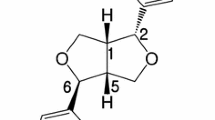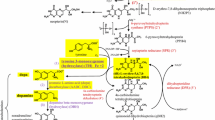Abstract
Aromaticl-amino acid decarboxylase (AADC) is involved in the synthesis of the putative neurotransmitters dopamine (DA), 5-hydroxytryptamine (5-HT), and trace amines some of which have been proposed as neuromodulators, such as 2-phenylethylamine and tryptamine. We report here that the gene expression of AADC can be regulated by the AADC inhibitor NSD-1015 in PC12 cells. The cells were treated with different doses of NSD-1015 (0.01–10 μM) for 3 days. Slot blot hybridization was performed to detect AADC mRNA and Western immunoblot to detect AADC protein. The cDNA probe for rat AADC was generated by reverse transcription from rat adrenal gland total RNA and was amplified by the polymerase chain reaction (PCR) method. The results demonstrated that NSD-1015 produced a concentration-dependent up-regulation in AADC mRNA levels which is followed by a stable increase in AADC protein. The results suggest that AADC is an enzyme that can be regulated at the level of gene expression. The finding may be of importance in the study of DA transmission and for an improved understanding of this enzyme.
Similar content being viewed by others
References
Christenson, J. W., Dairman, W., and Udenfriend, S., 1972. On the identity of DOPA decarboxylase and 5-hydroxytryptophan decarboxylase. Proc. Nat. Acad. Sci. U.S.A. 69:343–347.
Lovenberg, W., Weissbach, W., and Udenfriend, S., 1962. Aromaticl-amino acid decarboxylase.J. Biol. Chem. 237:89–93.
Boulton, A. A., 1976. Cerebral aryl alkyl aminergic mechanisms, inTrace Amines in the Brain. (Usdin, E. and Sandler, M., eds), pp 21–39. Marcel Dekker Inc. New York.
Brodie, B. B., Kuntzman, R., Hirch, C. W., and Costa, E., 1962. Effects of decarboxylase inhibition on the biosynthesis of brain monoamines.Life Sci. 1:81–84.
Langelier, P., Roberge, A. G., Boucher, R., and Poirier, L. J., 1973. Effects of chronically administered L-dopa in normal and lesioned cats.J. Pharmacol. Exp. Ther. 187:15–26.
Robins, E., Robins, J. M., Croninger, A. B., Moses, S. G., Spencer, J., and Hudgens, R. W., 1967. The low level of 5HTP decarboxylase in human brain.Biochem. Med. 1:240–251.
Lloyd, K. G., and Hornykiewicz, O., 1972. Occurrence and distribution of dopa decarboxylase in the human brain.J. Neurochem. 19:1549–1559.
Sacks, W., Vogel, W. H., Nagatsu, T., Lloyd, K. G., and Sandler, M., 1979. Round Table on: Is there Dopa decarboxylase in human brain? Pages 127–131,in Usdin, E., Kopin, I. J., and Barchas, J., (eds) Catecholamines: Basic and Clinical Fronners, Vol 1, Pergamon, New York.
Hadjiconstantinou, M., Rossetti, Z., Silvia, C., Krajnc, D., and Neff, N. H., 1988. Aromatic l-amino acid decarboxylase activity of the rat retina is modulated in vivo by environmental light.J. Neurochem. 51:1560–1564.
Zhu, M. Y., Juorio, A. V., Paterson, I. A., and Boulton, A. A., 1992. Regulation of aromatic 1-amino acid decarboxylase by dopamine receptors in the rat brain.J. Neurochem., 58:636–641.
Tanaka, T., Horio, Y., Taketoshi, M., Imamura, I., Ando-Yamamoto, M., Kangawa, K., Matsuo, H., Kuroda, M., and Waka, H., 1989. Molecular cloning and sequencing of a cDNA of rat dopa decarboxylase: partial amino acid homologies with other enzymes synthesizing catecholamines.Proc. Natl. Acad. Sci. USA 86:8142–8146.
Li, X-M., Juorio, A. V., Paterson, I. A., Walz, W., Zhu, M. Y., and Boulton, A. A., 1992. Gene expression of aromatic 1-amino acid decarboxylase in rat cultured glia cells.J. Neurochem. 59:1172–1175.
Li, X-M., Juorio, A. V., Paterson, I. A., Zhu, M. Y., and Boulton, A. A., 1992. Specific irreversible MAO B inhibitors stimulate gene expression of aromatic 1-amino acid decarboxylase in PC12 cells.J. Neurochem. 59, 2324–2327.
Gudehithlu, K. P., Duchemin, A. M., Silvia, C. P., Neff, N. H., and Hadjiconstantinou, M., 1992. Expression of cloned aromatic L-amino acid decarboxylase inXenopus laevis oocytes.Neurochem. Int. 21:275–279.
Hefti, F., Melamed, E., and Wurtman, R. J., 1981. The site of dopamine formation in rat striatum after L-DOPA administration.J. Pharmacol. Exp. Ther. 217:189–197.
Maniatis, T., Fritsch, E. F., and Sambrook, J., 1982. Molecular cloning: a laboratory manual. Cold Spring Harbor, New York.
Fainberg, A. P., and Vogelstein, B., 1983. A technique for radiolabelling DNA restriction endonuclease fragments to high specific activity. Anal. Biochem. 132:6–13.
Blaschko, H., 1959. The development of current concepts of catecholamine formation.Pharmac. Rev. 11:307–316.
Paterson, I. A., Juorio, A. V., and Boulton, A. A., 1990. 2-Phenylethylamine, a modulator of catecholamine transmission in the mammalian central nervous system?J. Neurochem. 55:1297.
Bowsher, R. R., and Henry, D. P., 1983. Decarboxylation ofp-tyrosine: a potential source ofp-tyramine in mammalian brain.J. Neurochem. 40:992–1002.
Levitt, M., Spector, A., Sjoerdsma, A., and Udenfriend, S., 1965. Elucidation of the rate-limiting step in norepinephrine biosynthesis in the perfused guinea pig heart.J. Pharmac. Exp. Ther. 148:1–8.
Rossetti, Z. L., Silvia, C. P., Krajnc, D., Neff, N. H., and Hadjiconstantinou, M., 1990. Aromatic 1-amino acid decarboxylase is modulated by D1 dopamine receptors in rat retina.J. Neurochem. 54:787–791.
Buckland P. R., O'Donovan, M. C., and McGuffin, P., 1992. Changes in dopa decarboxylase mRNA but not tyrosine hydroxylase mRNA levels in rat brain following antipsychotic treatment.Psychopharmacology 108:98–102.
Rosengren, E., 1960. Are DOPA decarboxylase and 5-hydroxytryptophan decarboxylase individual enzymes?Acta Physiol. Scand. 49:364–369.
Awapara, J., Sandman, R. P., and Hanly, C., 1962. Activation of DOPA decarboxylase by pyridoxal phosphate.Arch. Biochem. Biophys. 98:520–525.
Tatton, W. G., and Greenwood, C. E., 1991. Rescue of dying neurons, a new action for deprenyl in MPTP parkinsonismJ. Neurosci. Res. 30:666–672.
Salo, P. T., and Tatton, W. G., 1992. Deprenyl reduces the death of motoneurons caused by axotomy.J. Neurosci. Res. 31:394–400.
Author information
Authors and Affiliations
Rights and permissions
About this article
Cite this article
Li, XM., Juorio, A.V. & Boulton, A.A. NSD-1015 alters the gene expression of aromaticl-amino acid decarboxylase in rat PC12 pheochromocytoma cells. Neurochem Res 18, 915–919 (1993). https://doi.org/10.1007/BF00998277
Accepted:
Issue Date:
DOI: https://doi.org/10.1007/BF00998277




